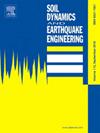土壤空间变异性对简化地震边坡位移评价的影响
IF 4.2
2区 工程技术
Q1 ENGINEERING, GEOLOGICAL
引用次数: 0
摘要
评估工程和天然边坡系统地震位移的简化程序取决于潜在滑动质量的动力阻力和地震荷载。通常,动力阻力由地震屈服系数来表示,地震荷载部分由滑动质量退化基期的谱加速度来表示。然而,边坡系统内部固有的土壤空间变异性会极大地增加这些变量的不确定性,而这些不确定性会传播到评估地震位移的不确定性中。本研究探讨了地下土壤变异性对一系列假设粘土边坡的地震屈服系数、滑动质量周期和估计位移的不确定性的影响。伪静力稳定性分析采用有限差分程序FLAC来逼近地震屈服系数、相关滑动质量几何形状和滑动质量周期。地震位移是用40次地面运动的简化程序确定的。采用不排水抗剪强度的对数正态空间随机场对土壤进行建模,并对平均值、变异系数和水平相关范围进行了替代假设。其他参数变化包括剪切波速、土壤抗剪强度表征和边坡几何形状的替代假设。结果表明,在解释地震位移实际评估的综合不确定性(即固有的土壤变异性和相关的偏差,加上建模不确定性)时,需要考虑重要因素。本文还讨论了将地面运动不确定性纳入模型并在基于性能的模型中使用这些发现的意义。本文章由计算机程序翻译,如有差异,请以英文原文为准。
Effect of soil spatial variability on simplified seismic slope displacement assessments
Simplified procedures for evaluating seismic displacements of engineered and natural slope systems depend on the dynamic resistance and seismic loading of the potential sliding mass. Typically, the dynamic resistance is proxied by a seismic yield coefficient, and the seismic loading is proxied in part by the spectral acceleration at the degraded fundamental period of the slide mass. However, inherent soil spatial variability within slope systems can significantly contribute to uncertainties in these variables, which can propagate to uncertainties in the evaluated seismic displacements. This study investigates the influence of subsurface soil variability on the resulting uncertainty in the seismic yield coefficient, slide mass period, and estimated displacements for a series of hypothetical clay slopes. Pseudostatic stability analyses were performed using the finite difference program FLAC for approximating the seismic yield coefficient, the associated slide mass geometry, and slide mass period. Seismic displacements were determined using a state-of-practice simplified procedure for 40 ground motions. The soil was modeled using lognormal spatial random fields of the undrained shear strength, with alternative assumptions for the mean, coefficient of variation, and horizontal correlation range. Other parametric variations included alternative assumptions for the shear wave velocity, soil shear strength characterization, and slope geometry. The results demonstrate important considerations for interpreting the combined uncertainty (i.e., inherent soil variability and associated biases, compounded with modeling uncertainty) for practical evaluations of seismic displacements. Implications for incorporating ground motion uncertainty and using these findings within performance-based models are discussed.
求助全文
通过发布文献求助,成功后即可免费获取论文全文。
去求助
来源期刊

Soil Dynamics and Earthquake Engineering
工程技术-地球科学综合
CiteScore
7.50
自引率
15.00%
发文量
446
审稿时长
8 months
期刊介绍:
The journal aims to encourage and enhance the role of mechanics and other disciplines as they relate to earthquake engineering by providing opportunities for the publication of the work of applied mathematicians, engineers and other applied scientists involved in solving problems closely related to the field of earthquake engineering and geotechnical earthquake engineering.
Emphasis is placed on new concepts and techniques, but case histories will also be published if they enhance the presentation and understanding of new technical concepts.
 求助内容:
求助内容: 应助结果提醒方式:
应助结果提醒方式:


